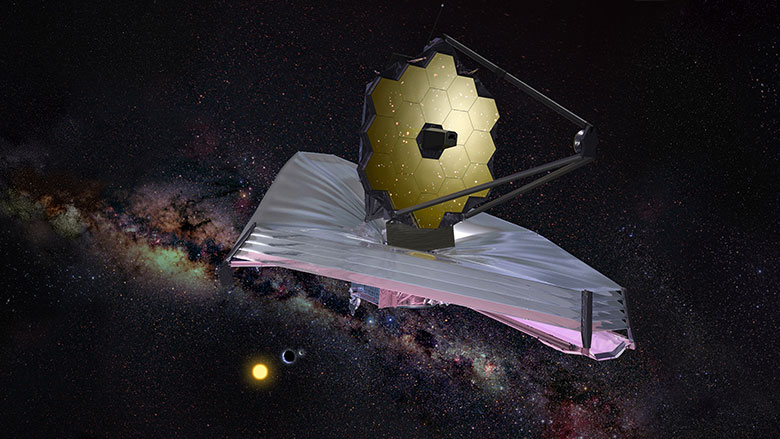In tandem with the launch of James Webb Space telescope and its journey to Lagrange point 2, we decided to republish this essay by Reza Negarestani from 2012. It was originally published in Savage Objects, ed. Godofredo Pereira (Guimarães: 2012).
__
The James Webb Space Telescope (sometimes called JWST) is a large infrared telescope with a 6.5-meter primary mirror. JWST will be the premier observatory of the next decade, serving thousands of astronomers worldwide. It will study every phase in the history of our Universe, ranging from the first luminous glows after the Big Bang, to the formation of solar systems capable of supporting life on planets like Earth, to the evolution of our own Solar System. (1)
An electromagnetic fable for the Enlightenment: From a global perspective, light is a connective operator that transports information in the form of electromagnetic radiation between different spatio-temporal fields. In other words, the global scope of light or electromagnetic radiation weaves a web of connections between heterogeneous regions of space-time or local fields of information. In this sense, the global conception of light reveals the global scope of complicities between different spatio-temporal regions, and in doing so, it illuminates the scope of the modern abyss as an informatic-objectal web. To put it differently, the universal scope of light expresses global-local transitions of objects, from global to local horizons and vice versa. Insofar as light connects incommensurable local fields of information, its global scope is always non-trivial in relation to its local scopes. An intuitive expression of this nontriviality is the twist of a Mobius strip. The Mobius strip is a bundle of line segments or local fibers over a circle. The global projection of these local sections will produce a section of a cylinder but not a Mobius strip which is a twisted bundle of local fibers. The non-triviality inherent to the global scope of light means that any local field of information or regional horizon on this web is, in a sense, blind or myopic to the global scope of light as the web of complicities between anonymous materials (i.e. incommensurable local fibers, different regions of space-time, objects and contrasting fields of information).
If we were to take the scope of this illumination seriously as a fable for a renewed Enlightenment, then what kind of observer or local viewpoint could be considered as the veritable subject of this rehabilitated project of Enlightenment? Would it not be an observer whose totality of its viewpoints are not given as a ready-made whole, since it is a mobile frame of reference, a raft so to speak, that builds the whole of its view by connecting local fields non-trivially in the aforementioned sense? Such an ambulant post-Copernican observer or post-Enlightenment subject then never is in a one-to-one confrontation—a phenomenological face-off—between its current frame of reference and the next one, between itself and the world. In this new paradigm, neither the whole of the perspective nor the whole of the world are given. The local viewpoint—the subject—is in this sense, the involution of the world into itself, and the world is a non-trivial construct of the local viewpoint as a mobile rather than a stationary frame. Here again, non-triviality means that the world does not correspond to the local characteristics of itself which are constitutive of the local viewpoint, and more importantly, only globally the world becomes a world as the navigation of a local frame of reference—the dialectical moves between here and there, up and down, back and forth, ascent and descent, focalization and scattering, the synchronic and the diachronic. We shall call such a deeping view, the telescopic, an apt term for a world and a subject which are incomplete.
An object-induced vertigo called knowledge: If the global scope of light illuminates the scope of the abyss as a web of perspectives-cum-objects and if light in its global scope is invisible to local perspectives, then in order to stare back into the abyss one must first reconstruct the global scope of light as what illuminates the abyss. Enlightenment should be, accordingly, understood as a response to the problem of illuminating the abyssality of the universe and bringing into focus its informatic-objectal web through the agency of a reason that does not emanate from the undeviating subjective vision but travels in the direction of a generic light. The edifice of knowledge committed to ambitions of the Enlightenment, likewise, can be seen as a system for developing optimal perspectives endowed with a universal orientation capable of conceiving information from different fields into an accessible global field through which information from heterogeneous local fields stream and can be subsequently synthesized and organized. In other words, as far as the Enlightenment is concerned, the productive valence of knowledge lies in its ability to reconstruct the global scope of illumination – light as a connective operator – by unleashing different perspectives upon the object so as to combine all these local perspectives into a global perspective. In conceiving its global web of illumination by agitating the object with optimal perspectives from all possible angles, knowledge thus becomes a universal strategy to embrace the abyss, the informatic-objectal web, immanent to the global scope of light wherein subjects or viewpoints are constructive transcendental localities from which the abyss stares into itself, perpetually descending. Yet insofar as embracing the abyss is the very idea of a systematic descent into it, knowledge can be understood as a global scheme for staring back, or more accurately, systematically descending into the abyss. If there is any meaning to the phrase world-soul, it is the fact that subjects are the mobile viewpoints or telescopic lenses through which the incomplete world develops a self-consciousness of itself. A systematic descent is comprised of global-local strategies for moving back and forth, ascending and descending between various vertiginous precipices of the abyss. However, it is important to recognize that such a gaze or systematic descent / navigation is purely conditioned by the object and its abyssal horizon of complicity with other objects.
Perspectives are genuine – true-to-the-object – agitations upon objects (2): According to the modern definition of knowledge, the gaze or the descent into the informatic-objectal abyss is constituted of systematic and optimal perspectives for approaching the object and accessing various layers, borders, levels of continuity and precipices of the abyss. Conditioned by the dialectics of depth and the geometrical outlines of the informatic-objectal web, the perspectives or navigational schemes of the modern knowledge can be effectively compared to descending and climbing equipments designed to navigate objects, from the precipice to the abyss, and vice versa. Perspectives are schematically classified on the basis of their ability and objective in approaching specific aspects of the global web of objects or performing particular navigational tasks: There are perspectives which are for the sole purpose of approaching objects from different borders and orbits (ropes and webbing gears), latching onto specific objects to facilitate the navigation of the entire abyssal web through temporal nodes (anchors), moving from one object or heterogeneous field of information to another, navigating different grades or continua of the abyss (rappels and ascenders) and various forms of control, protection and brake tools (belay devices) to pursue different approaches to the object and ensure an endurable and thorough navigation of the informatic-objectal web. (3)
In order to reconstruct the global scope of illumination and bring to light the informatic-objectal web invisible to a trivial conception or the old paradigm of the local subject, knowledge continuously strives to develop and synthesize non-trivial and optimal perspectives, multivalent navigational schemes or constructive subjective viewpoints. Rather than approaching the object from a limited range of local perspectives, the modern conception of knowledge adopts perspectives which are synthetic, capable of simultaneously approaching the object from different orbits and in different local contexts and modal frameworks so as to concurrently index and merge the microscopic (driven by internal differences), the macroscopic (integral according to the underlying flux of invariance), the panscopic (unitary or fusion of difference and integration), the synchronic and diachronic images of the object. The ambition of modern knowledge to develop synthetic perspectives and multi-valent navigational schemes should be understood in the context of modern knowledge’s recognition of Enlightenment as a global model of light wherein light is no longer issued forth from the eye but travels according to a generic informatic-objectal trajectory. In other words, modern knowledge develops and optimizes its perspectives and navigational schemes by continuously synchronizing them with non-trivial schemata of the objectal web. In a sense, the vertiginous precipices of the informatic-objectal abyss dictates modes and methods of descent. It is the object that lies at the base of agitations which induce the vertigo of knowledge and drive the ambition of the Enlightenment further down into the abyss, an abyss that is in the process of totalizing of itself as intelligible to itself.
A perspective accustomed to the global scope of light: The synthetic perspective or a perspective / navigational scheme synchronous with non-trivial schemata of the informatic-objectal web is the very idea of the telescopic view. As a view conditioned by and adapted to the vertiginous precipices of the abyss, the telescopic view (whether as a mode of perspective in culture, interpretation or astronomy) is a synthetic perspective with a universal orientation. It is a multi-modal perspective that weaves microscopic and macroscopic views of the object within a universal panscopic frame, hence preventing the engagement with objects from deteriorating into a whimsical orgy with objects where the bourgeoisie-curated cabinet of curiosities meets the circus-oriented metaphysics of objects. Accordingly, the telescopic view is able to intermediate differentiation and integration; on the one hand, indexing difference against an invariant background and on the other, bringing the universal backdrop of invariance beneath instances of difference into the foreground. In addition, the telescopic view is essentially a web-oriented view whereby local contraction and global expansion (decontraction) can be incorporated into a network of global-local correspondences and dialectics where dogmatic orientations toward one pole or another are dissolved. If there is one thing that the renwed Enlightenment hates the most is bipolarity in the order of subject-object, world and viewer. To this extent, the telescopic view is a perspective synchronous to the cosmological schema of an expanding universe with local instances of complexification and contraction. The telescopic view should be considered as a trans-regional and trans-modal perspective capable of examining the full extent of the TRANS prefix. From the particulate to the galactic to the stellar to the chemical to the planetary to the biological and social domains, the telescopic view is in constant transit between various global-local agitations of the object and the subject, between nature and culture, difference and integrality, universality and regionality. It is for this reason that Colombian mathematician Fernando Zalamea associates telescopics with trans-modernism, a trans-regional and trans-modal approach to culture and nature that topologically glues different cultural manifolds and knowledge-spaces such as microscopic and differential perspectives of post-modernism and the panscopic and integral views of modernism together. (4)
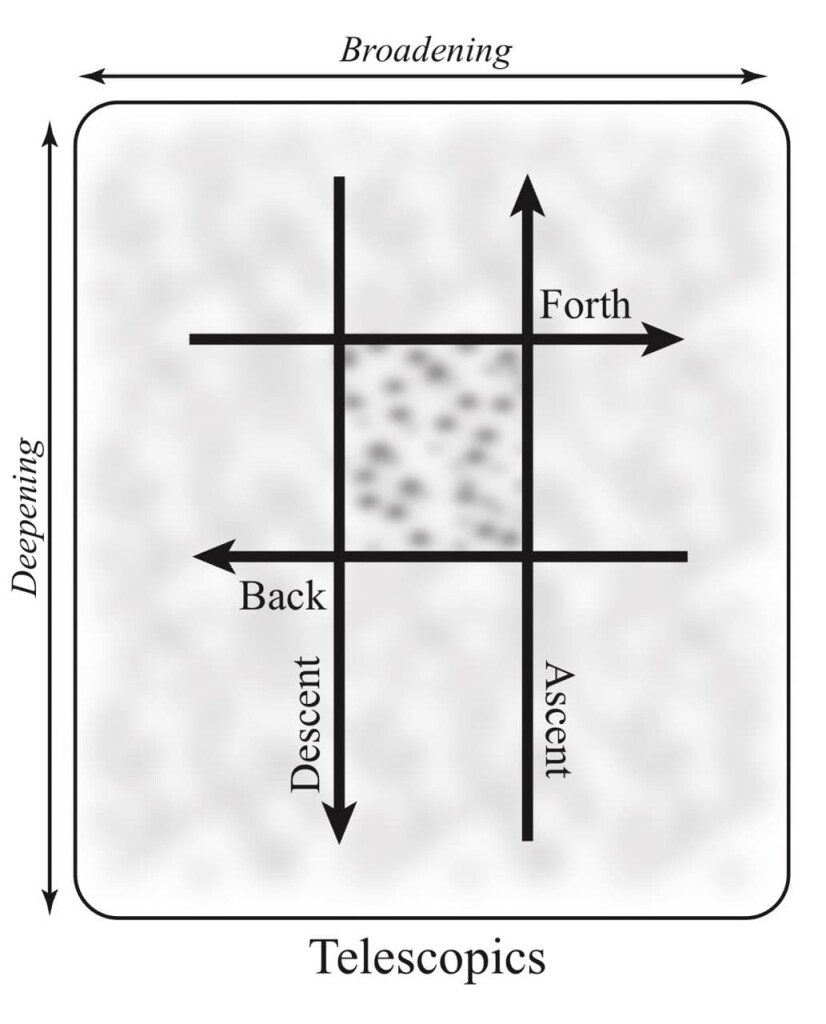
Figure 1. The telescopic view brings into focus the informatic-objectal web by interlocking back-and-forth navigation that broadens the scope along a unified horizon with ascent-and-descent navigation that deepens the scope across a diachronic depth.
From object to object, or the story of telescope from the perspective of the abyss: As a synthetic perspective conditioned by the global-local transitions of the subject-object or the precipices of the informatic-objectal abyss, the telescopic view should be considered as a mode of approach pivotal to the entire panorama of the modern account of knowledge. Indeed we can speak of a proto-schema of telescopic view even before the introduction of the first modern telescopes – a scheme, an ambition, an ideal for a subjectivity-yet-to-come forged in the universalist approaches of medieval scholastics and forerunners of optics. It is in this sense, that the true-to-the-object valence of the telescopic view should be seen as the drive behind some of the most sophisticated technological processes and engineering sparks leading to the development of modern telescopes and observatories. As far as the story of the modern telescope is concerned, global-local transitions of the object which shape the precipices of the abyss as the true object of Enlightenment condition and dictate an approach – a way to see, a scheme to navigate – toward objects. Conditioned by a non-bipolar subject-object relationship, this approach becomes a central idea within the system of knowledge that in turn instructs and directs its own embodiment into an object for facilitating the systematic descent into the abyss. The subject retrospectively becomes an object, a set of impersonal objective claims being revised, forever descending into the web of new connections which build it. From a speculative perspective within the system of modern knowledge, we can thus say that telescope is the non-trivial incarnation of the abyss staring into itself. In the last instance, telescope is but an instrumental object whose original schema should be found in the global web of objects — i.e., non-trivial constructions of subject’s field of reference or view — and its abyssal impact upon the foundation of knowledge, life, culture, technology and engineering through a global scope of light which is not immediately given in local perspectives.
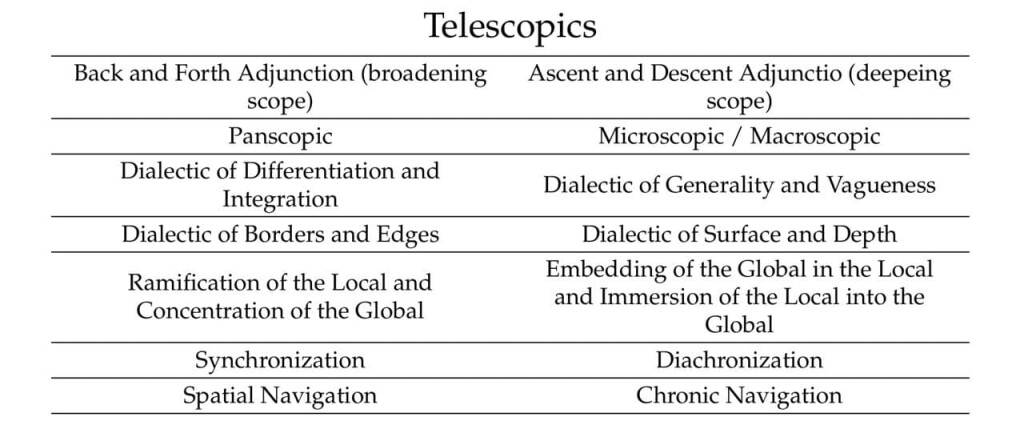
Table 1. Telescopics navigates the informatic-objectal web along two major navigational strategies, ascent!descent and back!forth adjunctions.
Telescopic descent, a space odyssey: The ambition of telescopic view in developing a universal and non-myopic approach to global-local transitions of the object highlighted by the global scope of light fully manifests in the advent of space telescopes. The object-induced vertigo of Enlightenment does not end with ever-complicating perspectives corresponding to the shifting precipices of the informatic-objectal abyss, it starts with uprooting from the dominant local horizon – the terrestrial sphere – that regulates or distorts the scope of various perspectives. The launch of telescopes into orbit should be seen as a systematic attempt to develop perspectives and schemata of a new vision not only liberated from the planetary constrains but also capable of observing the terrestrial cradle of life itself as an object within the continuous objectal web of the abyss. As a true heir to the legacy of the Copernican orbital subversion of the Earth, Hubble Space Telescope took the idea of observation into orbit where light is neither filtered nor distorted by the Earth’s atmosphere. The imminent arrival of second generation space telescopes headed by James Webb Space Telescope (JWST), however, broadens the scope of human knowledge and its telescopic descent into the abyss even further. The deployment of JWST at the second Sun-Earth Lagrange point (5) outside of the Earth’s own orbit takes the idea of Copernican uprooting of the ground in favor of the abyss multiple steps further. Not only is the terrestrial scope of illumination abandoned in favor of an orbital illumination – implicit in the very idea of Copernican Revolution – but also the earth’s orbit and the solar scope of light are left behind in favor of a more global, more abyssal scope of light as what illuminates the web of cosmological objects. Both visible light as a scope of light fully in conformity to the biological capacities of the terrestrial organism and sunlight as a conception of light fully ingrained within the ambit of terrestrial life have created a local environment that has been for far too long misunderstood as a global vista proper to a universal subjectivity and vision. By shifting its emphasis to infrared light 930,000 miles away from the Earth where it will float against a background with minimum heat radiations in one of the coldest environments possible, JWST will be able to detect infrared radiations coming through clouds of dust and emitted by the dimmest of objects, peering into the earliest stages of the universe. In doing so, the future telescope will illuminate a geocosmic continuum that connects the inception of the universe to the galactic, stellar and planetary horizons.
JWST and objects behind the Sun: Comprised of a segmented and cryogenically controlled (operating temperature under 50 Kelvin) primary mirror with the collecting area of 25 m2, JWST will orbit around the Earth-Sun second Lagrange point. In an optical and metaphorical gesture, JWST will face away from the Sun and will be shielded from radiation from the Sun, the Moon and the Earth. The telescope is designed to primarily work with infrared light rather than invisible light (Hubble telescope). Shielding of the telescope from solar and terrestrial radiations as well as cryogenic control of the mirror’s temperature enable JWST to detect near and mid ranges of the infrared spectrum of light with minimal distortion. Being a low-frequency spectrum of light that has been stretched toward its red end, infrared illuminates global-local transitions of objects in a universe that has been expanding since its inception. Since light from objects stretches as it travels across an expanding space, the further the object in time (conceived in the early stages of the universe and now dead, extinct or frayed into the open) the more stretched the wavelength of its light toward the red end of spectrum. Therefore, the global-local transition of objects through electromagnetic radiation or light in an expanding universe always tends to the red end of the spectrum as objects of study go further back in time. This shift toward the red end of the spectrum (infrared wavelength) for objects of ancestral time is known as cosmological redshift: The further the object in time, the more stretched its light across the accelerating expansion of space, the redder the object.
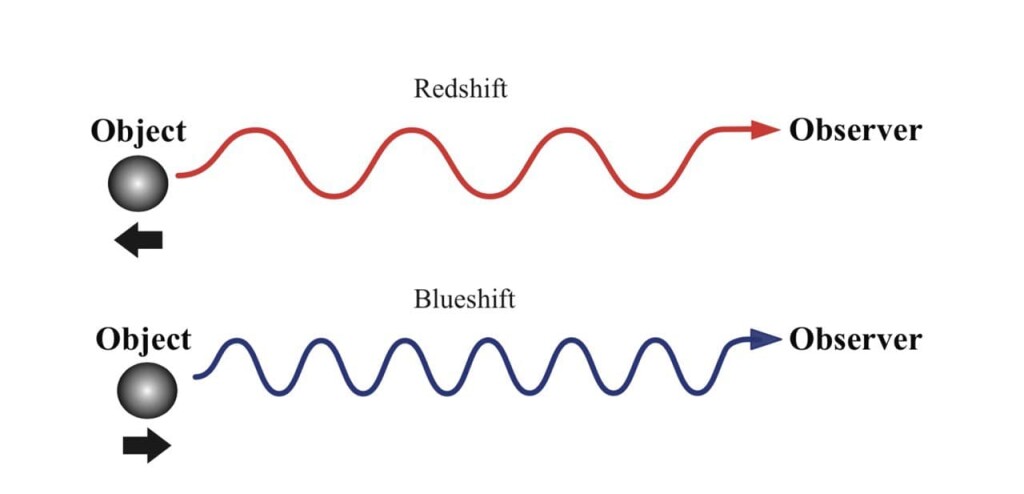
Figure 2. Redshift and Blueshift
Cosmological redshift, accordingly, illuminates the global conception of objects as that which is independent of a time that can synchronize the subject with the object. JWST primarily sees the universe in light of this diachronicity of the object that enforces the scope of the abyss as an ever-expanding web of information and objects. Whereas Hubble Space Telescope opened the modern system of knowledge to the imports and implications of an expanding universe, JWST has been specifically designed to work within and in accordance with an expanding universe where frontiers – in an accelerated manner – fray into the open. For JWST, abyssality is, therefore, neither a conclusion nor a goal but the veritable environment for the operation of knowledge and approaching the global conception of the object implicit in the global scope of light. Since JWST is primarily optimized to see the universe through cosmological redshift – or light in an expanding universe – it is able to illuminate the global conception of the object in terms of a non-trivial and abyssal distance from the subject, an inaccessible distance that is best understood as diachronicity of the object. Incommensurable to the chronology of the thinking / seeing subject, the diachronicity or the inaccessible distance of the object expresses the identity of the abyss as what occasions the telescopic descent of knowledge. Far from being an obstacle for the edthat of the tension within the nervous system caused by an index of exteriority to that of a universal tension caused by the diachronicity of the object, then it is easy to see JWST’s observational strategy within the cosmological reinscription of trauma: The space telescope approaches the global conception of the diachronic object or the source of trauma by way of synthesizing its trace i.e. light stretched across the fabric of space. In other words, JWST translates the spatial trace of diachronicity or the infrared light into an image of the ancestral object. More than being a new pinnacle of human technology, JWST as an object of knowledge is a new ‘drive’ (in the sense of not only trieb but also instrumentum) for binding the trauma of the object and reshaping the plastic edifice of knowledge along its line of observation. Telescopic compossibilization of subject and object, ascent and descent, back and forth: Even though the impact of the trauma of the object upon the system of knowledge is ineradicable and the compulsion to approach the source of trauma – the diachronic truth of the object – constitutes the course of knowledge, the prospect of epistemological reactivation and amplification of the ontological condition of knowledge is not by any means a matter of a given privilege or fait accompli. The realization of JWST as a future object through which knowledge translates its ontological kernel into an epistemological navigational scheme or rational odyssey for descending into the abyss depends on, first of all, a subjective guarantor. The task of this subjective guarantor is to demarcate the boundaries and conditions of the local and disentangle the subject from the object so as to identify local exigencies and rationally engage them. The current precarious status of JWST as a an object that has turned into a fiscal black hole devouring other space and research programs requires a subjective return to local conditions that are more in accord with the epistemological horizon of knowledge rather than its ontological kernel. From a local perspective, JWST as a contingent object is a projection of the world’s economic and sociocultural priorities which themselves have been brought forth by the current epistemological status begotten by the historical evolution of the sort of subject we deem ourselves to be, and the world we take for granted as correlated to this exact subject. In short, these priorities are the results of how we understand ourselves and the world we inhabit. Only a universalist subjectivity determined to work out the priorities of a world ravaged by myopia and violence by renegotiating local epistemological views which underpin such priorities is able to evaluate, determine and globally establish the objective valence of the future telescope. The return to local exigencies and commitment to the epistemological horizon do not represent a reactionary fall upon the earthly ground but the synchronization of the universalist subject with the telescopic enlightenment: simultaneously, bringing the microscopic and the local to a universal elevation and bringing into focus the universal into its local exigencies, priorities and problems. Or to be concise: bringing into compossibility ascent and descent, back and forth in order to coherently interweave different depths or vertiginous precipices of the objective of knowledge, this inaccessible distance becomes as we shall see the source and the drive of knowledge as the sum of all perspectives or agitations upon the object.
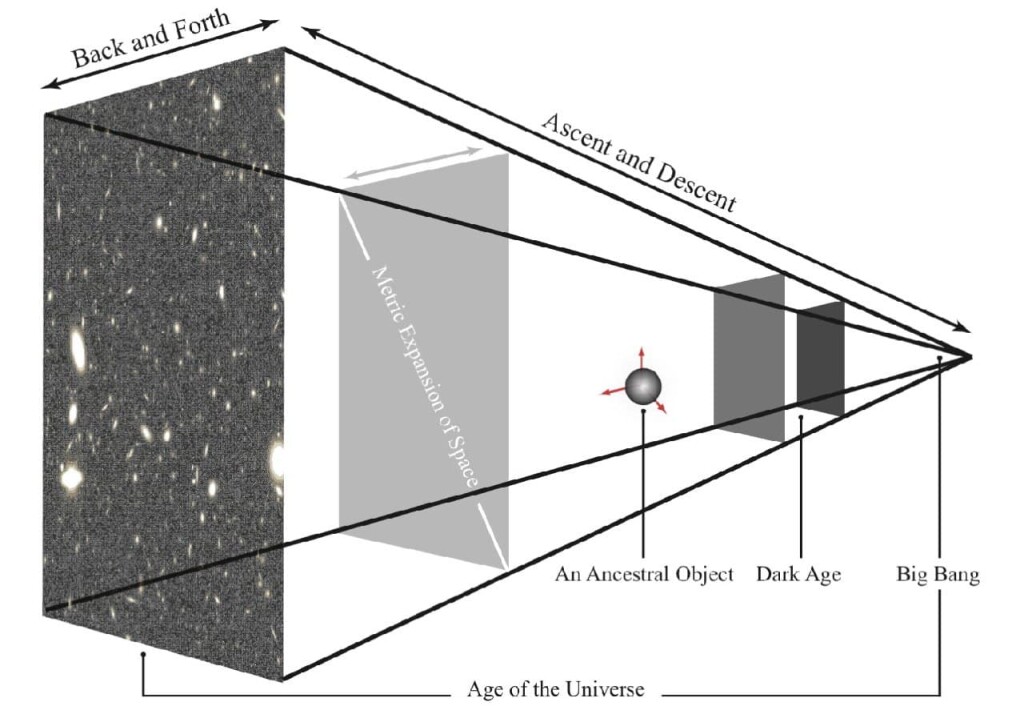
Figure 3. Telescopic enlightenment: Expansion of space and the diachronicity of the object (or the trauma of spacetime) condition the telescopic approach of (universal) knowledge.
JWST, an augmented strategy for approaching the trauma of the object: The chronic truth of the object lies outside of the time in which the subject thinks, sees and reflects. The diachronicity of the object constitutes the very trauma of the object for the seeing or thinking subject. The diachronic object is, therefore, a source of an unbindable tension that can neither be fully overcome nor extricated from the subject, yet nevertheless it is a tension around which the entire analytico-synthetic apparatus of knowledge and the subject takes shape and revolves. In the same vein, the subject continuously re-experiences the trace of trauma in order to obliquely approach the exterior source of trauma, it can be said that the system of knowledge is but a maze or an oblique navigation of the diachronic truth of the object. If knowledge is a system built upon and driven by the trauma of the object, then it becomes a compulsory objective for knowledge to produce its own objects through which the tension of this trauma can be resolved. As an object ideated, schematized and shaped by the system of knowledge and respectively, the trauma of the object indwelling within that system, the telescope exercises the traumatic power of the object on the subjective vision. It simply shapes, or more precisely, objectifies the vision of the observer according to the trauma of the object as a diachronic truth. The scientific instrument, JWST in this case, can only be examined within the nested hierarchy of objects: It is an object conceived by tensions produced by the trauma of the object within the system of knowledge. In short, the scientific instrument bears the imprint of the object upon the system of knowledge in the form of a compulsion to further delve into the diachronic truth of the object. If we broaden the Freud-Ferenczian theory of trauma (6) – according to a new cosmological continuum that connects the galactic to the cerebral – from that of the tension within the nervous system caused by an index of exteriority to that of a universal tension caused by the diachronicity of the object, then it is easy to see JWST’s observational strategy within the cosmological reinscription of trauma: The space telescope approaches the global conception of the diachronic object or the source of trauma by way of synthesizing its trace i.e. light stretched across the fabric of space. In other words, JWST translates the spatial trace of diachronicity or the infrared light into an image of the ancestral object. More than being a new pinnacle of human technology, JWST as an object of knowledge is a new ‘drive’ (in the sense of not only trieb but also instrumentum) for binding the trauma of the object — that is, not to see the world confronting the subject but the subject as the invultion of the world into itself — and reshaping the plastic edifice of knowledge along its line of observation.
Telescopic compossibilization of subject and object, ascent and descent, back and forth: Even though the impact of the trauma of the object upon the system of knowledge is ineradicable and the compulsion to approach the source of trauma – the diachronic truth of the object – constitutes the course of knowledge, the prospect of epistemological reactivation and amplification of the ontological condition of knowledge is not by any means a matter of a given privilege or fait accompli. The realization of JWST as a future object through which knowledge translates its ontological kernel into an epistemological navigational scheme or rational odyssey for descending into the abyss depends on, first of all, a subjective guarantor. The task of this subjective guarantor is to demarcate the boundaries and conditions of the local and disentangle the subject from the object so as to identify local exigencies and rationally engage them. The current precarious status of JWST as an object that has turned into a fiscal black hole devouring other space and research programs requires a subjective return to local conditions that are more in accord with the epistemological horizon of knowledge rather than its ontological kernel. From a local perspective, JWST as a contingent object is a projection of the world’s economic and sociocultural priorities which themselves have been brought forth by the current epistemological status. In short, these priorities are the results of how we understand ourselves and the world we inhabit. Only a universalist subjectivity determined to work out the priorities of a world ravaged by myopia and violence by renegotiating local epistemological views which underpin such priorities is able to evaluate, determine and globally establish the objective valence of the future telescope. The return to local exigencies and commitment to the epistemological horizon do not represent a reactionary fall upon the earthly ground but the synchronization of the universalist subject with the telescopic enlightenment: simultaneously, bringing the microscopic and the local to a universal elevation and bringing into focus the universal into its local exigencies, priorities and problems. Or to be concise: bringing into compossibility ascent and descent, back and forth in order to coherently interweave different depths or vertiginous precipices of the object.
This text was originally published in Savage Objects, ed. Godofredo Pereira (Guimarães: 2012).
_____
Note
1. The National Aeronautics and Space Administration (NASA), About the Webb, Available at: <http://www.jwst.nasa.gov/about.html>.
2. “Though ‘navigation’ stems from Latin ‘navigare’, and this one from ‘navis’ plus ‘agere’, which means giving motion to a ship, the present meaning of “navigation” is restricted to the passive steering of a vehicle which is already moved by some motor. However, navigation on the EncycloSpace must regain the original activity, since EncycloSpace has been determined as an interactively handled body of knowledge, a body which is not built, altered and developed by mysterious forces but by our genuine agitation upon the object. Therefore, the original etymology of ‘navigation’ is restituted: We shall distinguish between receptive and productive navigation. Receptive navigation means moving around within the body of knowledge without changing it. In contrast, productive navigation does change the body of knowledge.” See Guerino Mazzola, The Topos of Music: Geometric Logic of Concepts, Theory, and Performance (Basel: Birkhäuser, 2003), pp. 43-44. For more details on navigational characteristics of knowledge with regard to objects, see Mazzola’s book particularly chapter 2 (Topography) and chapter 5 (Navigation on Concept Spaces).
3. These simple climbing equipments effectively represent the modern definition of perspective as a navigational line that yields orientation and can ascend and descend between the local and the global through different ‘seemingly impossible’ paths and alternative orientations. Each perspective carries its ontological space “like a snake carrying its shell” (Mazzola, Ibid. 50).
4. See Fernando Zalamea, América – Una Trama Integral: Transversalidad, Bordes y Abismos en la Cultura Americana (Bogota: Universidad Nacional de Colombia, 2009).
5. Lagrange points are locations in space at which a small mass can orbit at a fixed distance from the larger masses due to the balance between the centrifugal force and the two gradational forces associated with larger masses, for example, the Sun and the Earth.
6. According to Freud and Hungarian psychoanalyst, Sandor Ferenczi, trauma is understood not as what is experienced by the subject but as an inassimilable index (for the subject) whose reality is exterior and diachronic to the order of conscious experience.
